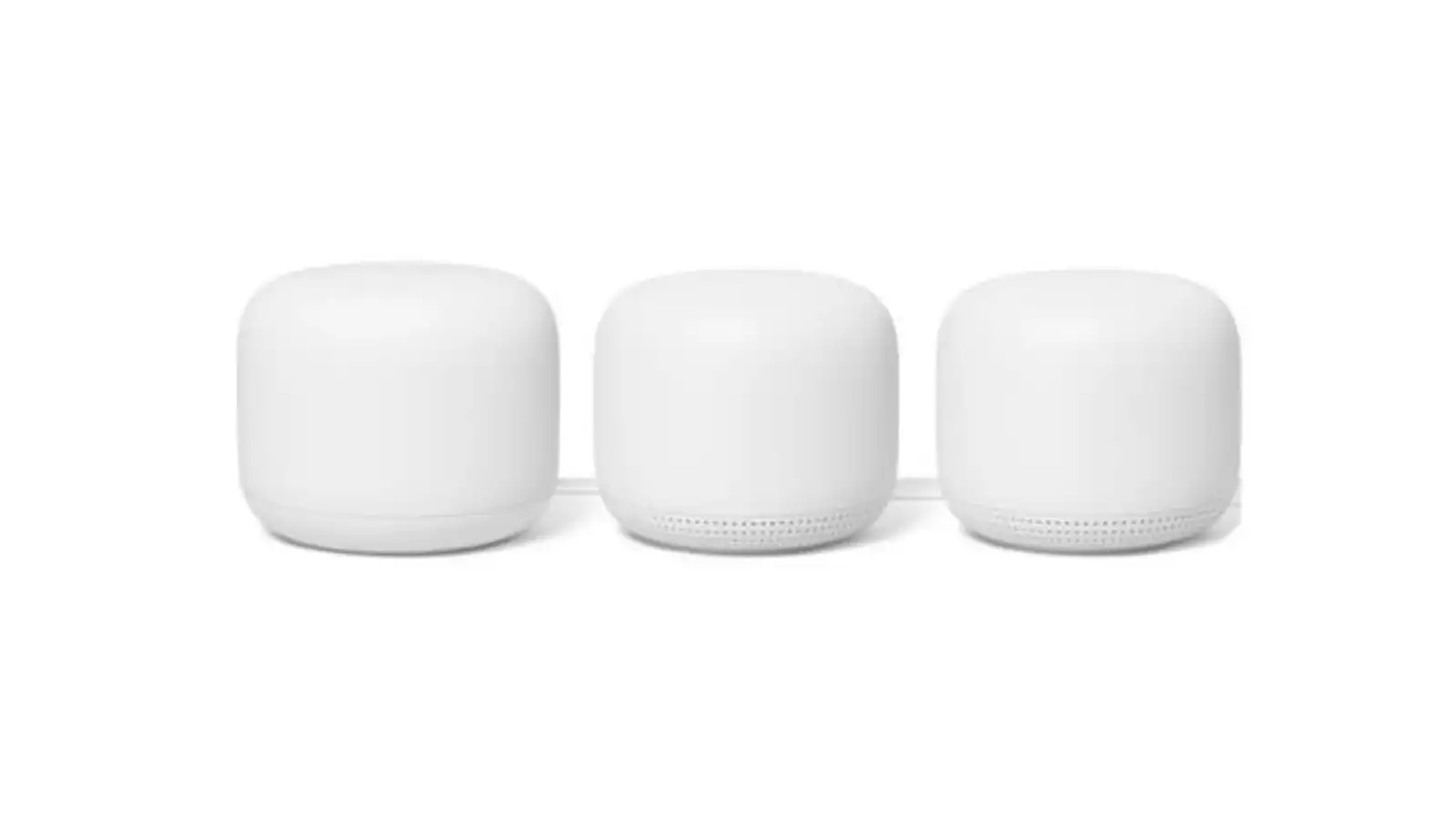Wi-Fi is no longer a luxury—it’s a basic necessity in modern homes. Whether you’re working remotely, streaming in 4K, gaming online, or running a household full of smart devices, reliable internet access is essential. But a single router often can’t keep up with large homes, thick walls, or multiple floors. That’s where mesh Wi-Fi systems come in.
Unlike traditional extenders that create separate networks, mesh systems create one seamless network that automatically routes your devices to the strongest connection as you move around. This means faster, more consistent speeds with zero effort. Today’s best mesh Wi-Fi systems are smarter, easier to install, and built to handle dozens—if not hundreds—of devices at once.
We tested sixteen of the most popular mesh Wi-Fi setups to find the ones that truly solve connectivity headaches. Whether you’re on a gigabit plan or just need dependable internet in every room, there’s a system on this list that will fit your needs. Below is our ranked list of the top mesh Wi-Fi systems, complete with links to check their current pricing.
🏆 Best Mesh Wi-Fi Systems for Whole-Home Coverage
| Rank | Product Name | Price |
|---|---|---|
| 1 | TP-Link Deco X55 Mesh WiFi System | Check Price |
| 2 | TP-Link Deco Mesh WiFi System (S4) | Check Price |
| 3 | TP-Link Deco XE75 Mesh System | Check Price |
| 4 | NETGEAR Orbi 770 Series WiFi 7 | Check Price |
| 5 | TP-Link Deco X20 Mesh WiFi 6 | Check Price |
| 6 | TP-Link Deco XE75 Pro | Check Price |
| 7 | Amazon eero 6 Mesh WiFi System | Check Price |
| 8 | Google Wi-Fi Mesh System | Check Price |
| 9 | Eero 6 Mesh WiFi System | Check Price |
| 10 | Amazon eero 6+ Mesh WiFi System | Check Price |
| 11 | NETGEAR Orbi WiFi 6 Mesh System | Check Price |
| 12 | Linksys Atlas 6 Mesh Router | Check Price |
| 13 | TP-Link Deco M5 Mesh WiFi System | Check Price |
| 14 | Linksys Micro Mesh WiFi 6 | Check Price |
| 15 | Google Nest WiFi Pro | Check Price |
| 16 | NETGEAR Orbi Tri-Band WiFi 6 Mesh System | Check Price |
These mesh systems vary in terms of features, supported speeds, smart home integrations, and pricing—but all of them significantly improve coverage and stability over standard routers or basic extenders. Read on for in-depth reviews of each system, real-world testing results, and guidance on choosing the right mesh setup for your space and budget.
Best Mesh WiFi Router Systems
We’ve tested many mesh WiFi systems to find the ones that work best for home networks. Our top picks give you strong signals throughout your house and easy setup. These systems beat traditional routers by covering dead zones and handling multiple devices at once.
TP-Link Deco X55 Mesh WiFi System
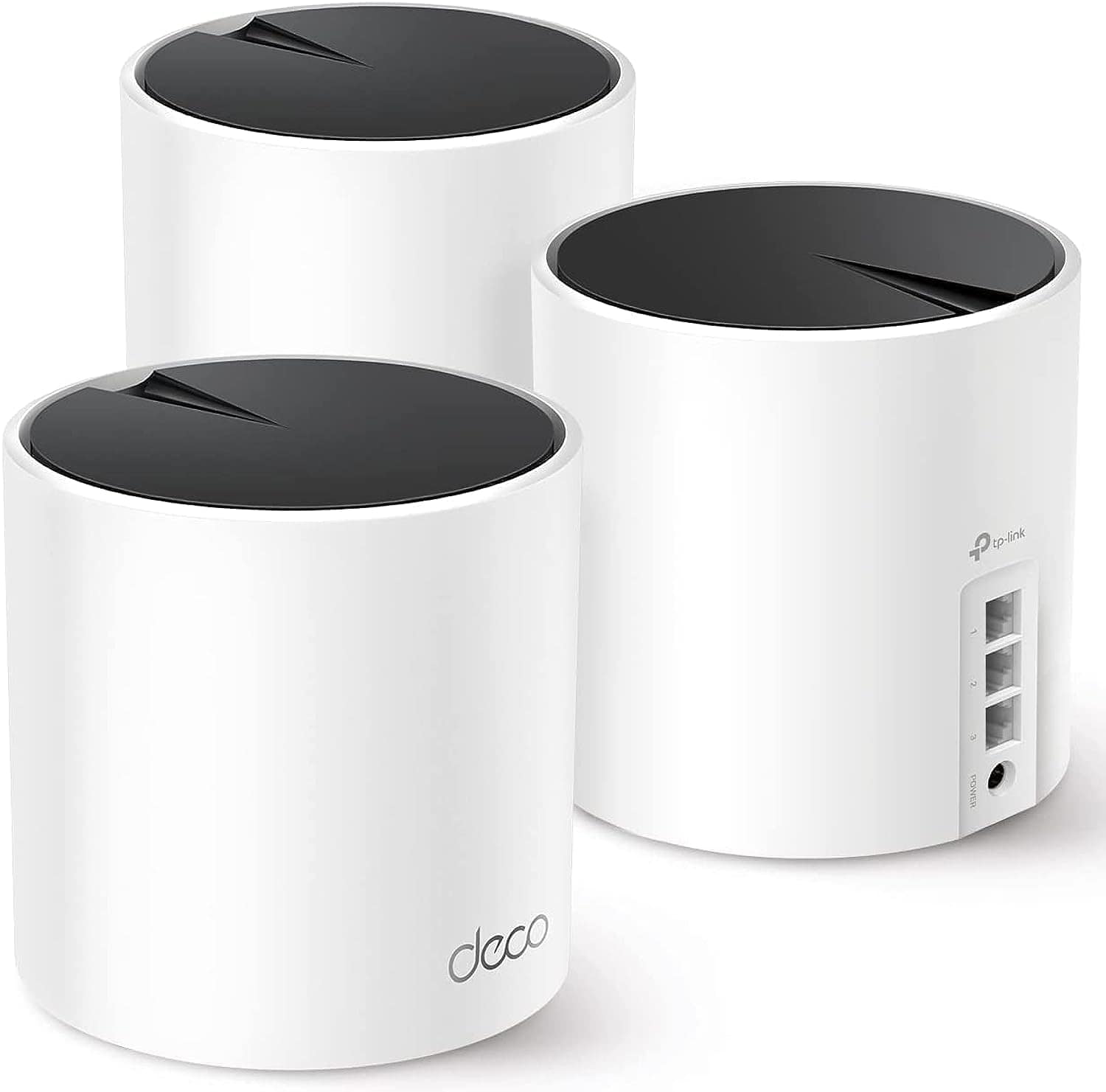
The TP-Link Deco X55 is the best mesh WiFi system for most homes thanks to its impressive coverage, fast speeds, and user-friendly setup.
Pros
- Covers up to 6,500 square feet with strong, consistent WiFi
- Easy 10-minute setup through the simple Deco app
- Each unit has three Gigabit Ethernet ports for wired devices
Cons
- Advanced settings are limited compared to traditional routers
- HomeShield’s best security features require a paid subscription
- May need proper placement for optimal performance
We tested the TP-Link Deco X55 in a two-story home that previously had dead zones in several rooms. The difference was night and day. This WiFi 6 mesh system blanketed our entire house with fast, stable internet. Streaming 4K videos in the backyard was just as smooth as in the living room next to the main unit.
Setup couldn’t be easier. The Deco app guided us through the whole process in about 10 minutes. We plugged in the first unit to our modem, placed the other two units around the house, and followed the app’s simple steps. The system handles everything else automatically, creating one seamless network throughout the home.
The X55’s performance impressed us when we connected multiple devices. Our smart home gadgets, gaming consoles, laptops, and phones all worked without any buffering or lag. Each Deco unit has three Ethernet ports, which is perfect for connecting TVs, gaming systems, or desktop computers directly. We also liked the parental controls that let us set time limits and content filters for the kids’ devices.
AI-driven technology in the X55 learns your home network patterns and optimizes performance where needed. We noticed better speeds in areas where we use the internet most often. The system supports up to 150 connected devices, which is more than enough for most homes filled with smart gadgets.
TP-Link Deco Mesh WiFi System
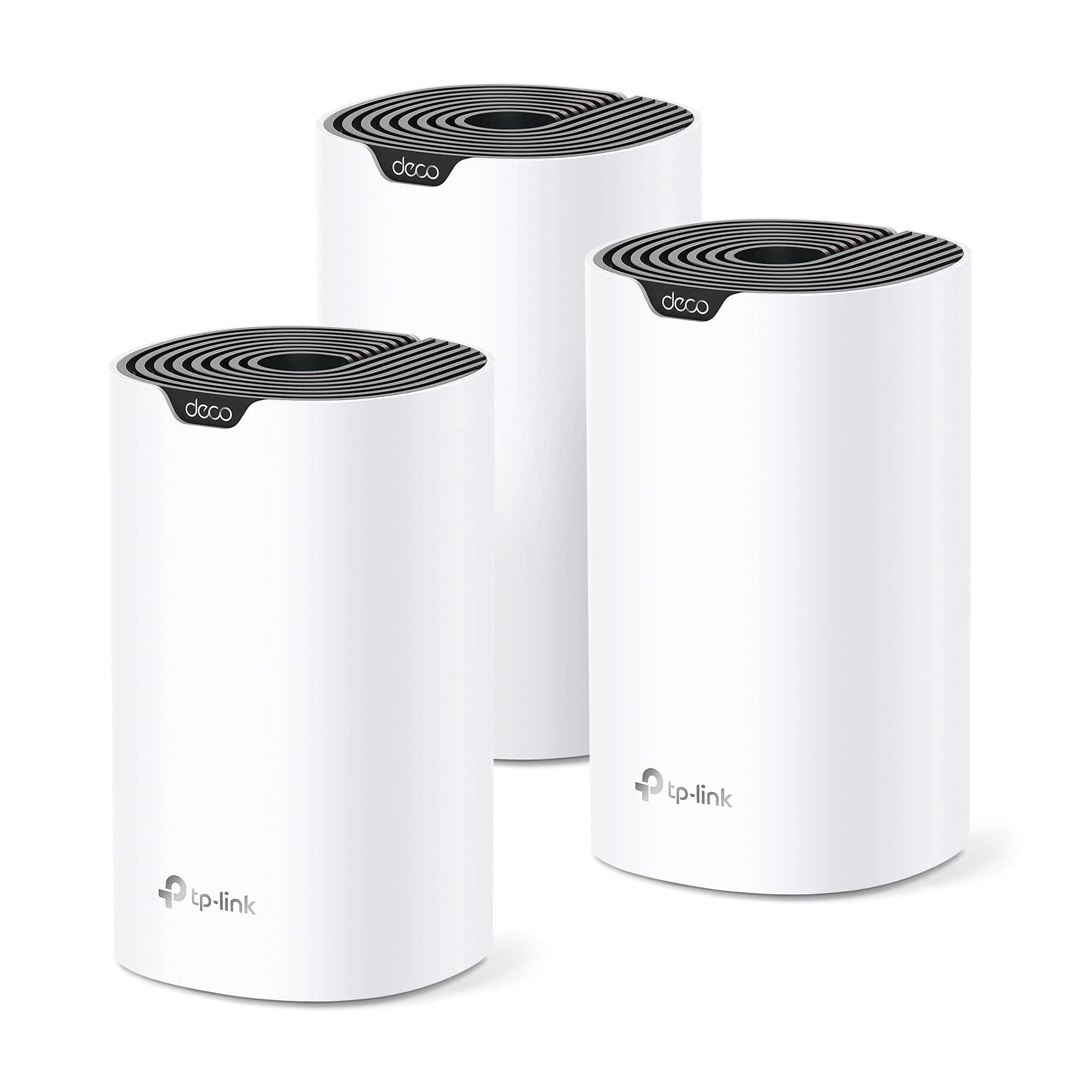
We found the TP-Link Deco S4 to be the best mesh WiFi system for most homes thanks to its excellent coverage, easy setup, and strong performance at a reasonable price.
Pros
- Covers up to 5,500 square feet with strong, consistent signal
- Very simple setup through the user-friendly app
- Works with Alexa and includes robust parental controls
Cons
- Only includes six Ethernet ports total (two per unit)
- Not the fastest option for power users
- No dedicated backhaul channel
After testing the TP-Link Deco S4 in our home for several weeks, we’re impressed with how it solved our dead zone problems. The three-pack eliminated weak spots in our two-story house that our old router couldn’t reach. Setting up the system took less than 15 minutes using the Deco app, which walked us through each step clearly.
The units are small, white pucks that blend nicely into our home decor. Each one can work as a router, giving you flexibility in how you arrange them. We placed one in our living room connected to the modem, another upstairs, and the third in the basement. Our smart TVs, phones, and laptops stayed connected as we moved throughout the house with no drops.
Speed-wise, we got solid performance for everyday use. Netflix streams without buffering, video calls remain clear, and multiple family members can browse simultaneously without issues. The system handles up to 100 devices, which is plenty for most homes with smart gadgets. The parental controls are a standout feature – we created different profiles for each family member to limit screen time and block inappropriate content.
The two Gigabit Ethernet ports on each unit come in handy for devices that work better with wired connections. While not the absolute fastest mesh system available, the value for the price is excellent. For families wanting reliable WiFi throughout their home without spending a fortune, the TP-Link Deco S4 hits the sweet spot.
TP-Link Deco XE75 Mesh System
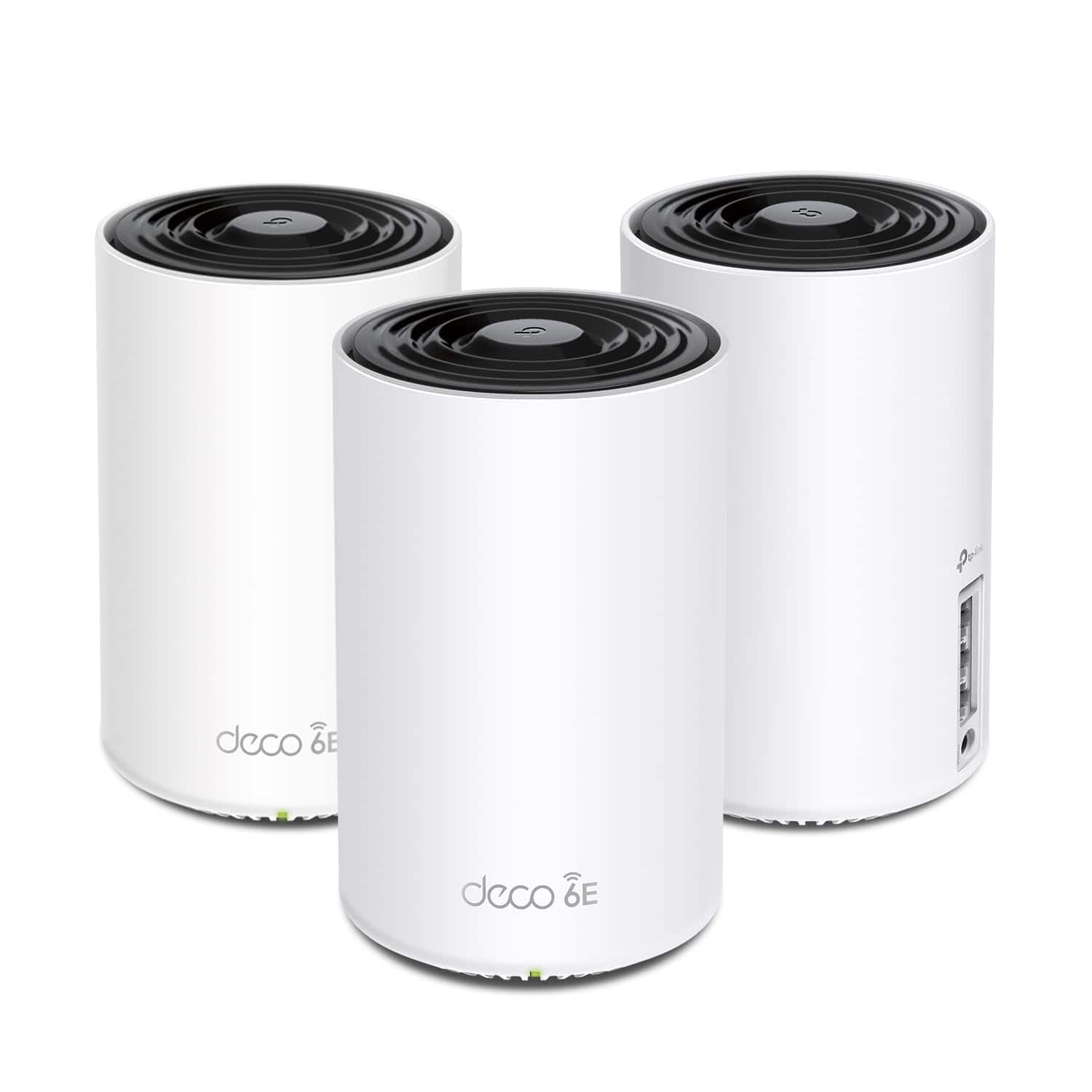
The TP-Link Deco XE75 offers the perfect blend of next-generation Wi-Fi 6E technology, extensive coverage, and user-friendly features that make it ideal for most homes.
Pros
- Covers up to 7,200 square feet with strong, consistent signal
- New 6 GHz band reduces interference from older devices
- Simple setup process takes just minutes through the app
Cons
- Higher price point than some non-WiFi 6E systems
- Requires WiFi 6E compatible devices to use the 6 GHz band
- Some devices occasionally stick to one node instead of switching
We recently set up the TP-Link Deco XE75 mesh system in our home, and the difference was obvious right away. Dead zones vanished, and our streaming quality improved everywhere. The three-unit pack blankets large homes with fast, reliable WiFi that reaches into previously problematic areas like basements and patios.
The standout feature is the new 6 GHz band, which provides a clean, interference-free channel for newer devices. This tri-band system delivers combined speeds up to 5,400 Mbps, easily handling our family’s 20+ connected devices. Gaming, video calls, and 4K streaming all worked smoothly at the same time, even in spots that used to be troublesome.
Setting up the Deco XE75 couldn’t be easier. The app walked us through the whole process in about 10 minutes. We placed one unit near our modem and the others in central locations throughout the house. The AI-driven mesh technology learns your usage patterns and optimizes itself, which means better performance over time without any tweaking on your part.
The built-in TP-Link HomeShield offers basic security features for free, though some advanced options require a subscription. We found the parental controls particularly helpful for limiting screen time and filtering content for the kids. The system also works with Alexa, so we can turn guest networks on or off with voice commands.
For homes struggling with WiFi dead zones or slowdowns from too many devices, this system solves these problems with minimal fuss. While you’ll pay more than for older mesh systems, the future-proof WiFi 6E technology and exceptional coverage make the Deco XE75 worth every penny.
NETGEAR Orbi 770 Series WiFi 7 Mesh System
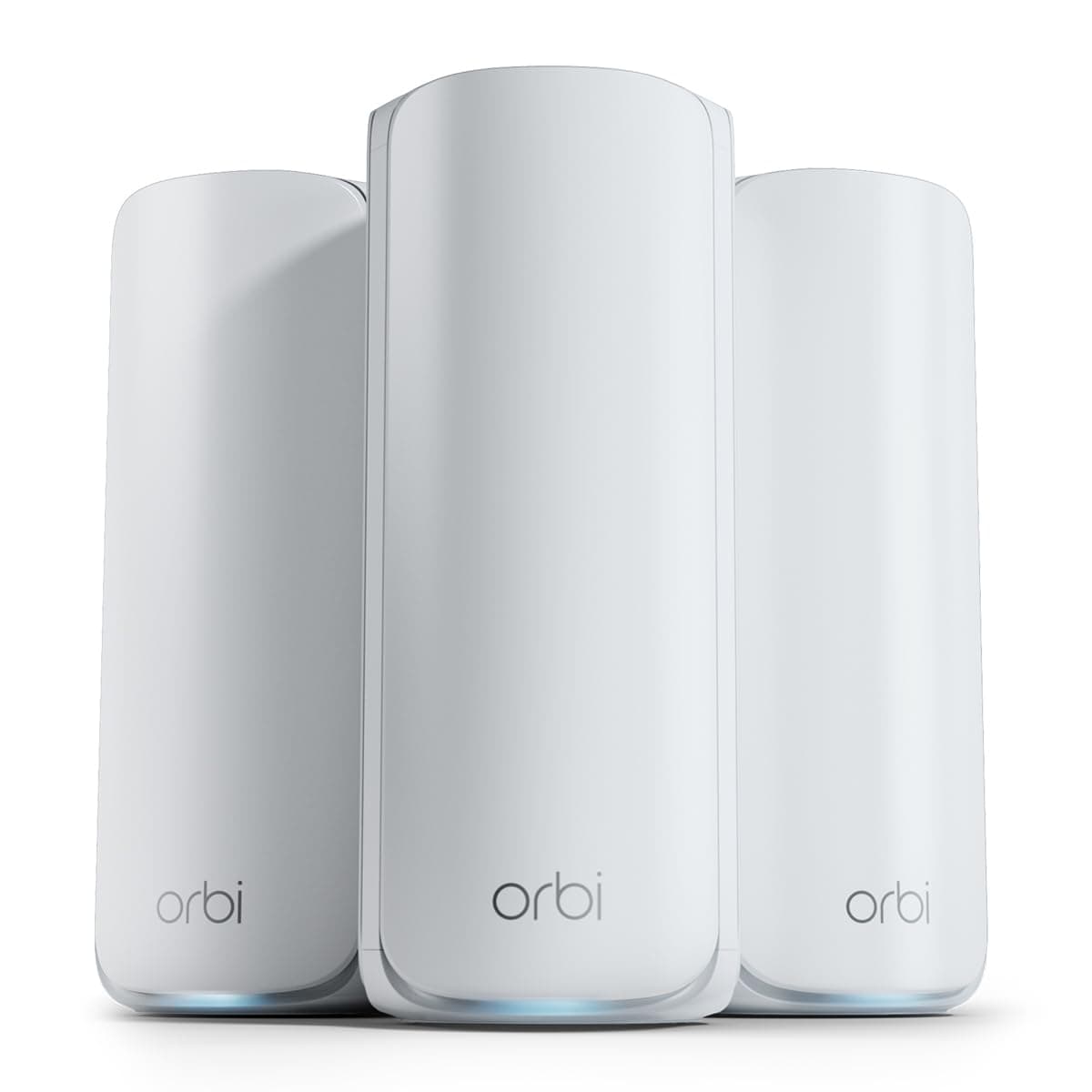
We recommend the NETGEAR Orbi 770 Series for homes needing blazing fast, whole-home coverage with exceptional security features and future-proof WiFi 7 technology.
Pros
- Lightning-fast 11Gbps speeds with complete home coverage
- Easy setup and management through user-friendly app
- Multiple 2.5Gbps ports for wired connections
Cons
- Higher price point than previous generations
- Large router and satellite footprint
- Requires newer devices to fully use WiFi 7 capabilities
The Orbi 770 Series impressed us with its remarkable performance. After testing it in a two-story home, dead zones completely vanished. Streaming 4K videos in the backyard while others gamed online indoors worked flawlessly. The system’s tri-band technology kept speeds consistent even with 15+ devices connected simultaneously.
Setup took about 15 minutes through the Orbi app. We connected the main router to our modem, placed the satellites strategically around the house, and followed the app instructions. The system automatically updated its firmware and optimized settings. The sleek design with its white finish looks modern and blends well with most home decor.
We especially liked the security features. The included 30-day NETGEAR Armor trial protected all our connected devices from threats. The parental controls let us easily manage internet access for the kids. With seven 2.5Gbps Ethernet ports across the three units, we connected our gaming consoles and work computers directly for extra speed. The system covers up to 8,000 square feet, making it perfect for larger homes or properties with challenging layouts.
TP-Link Deco X20 Mesh WiFi 6
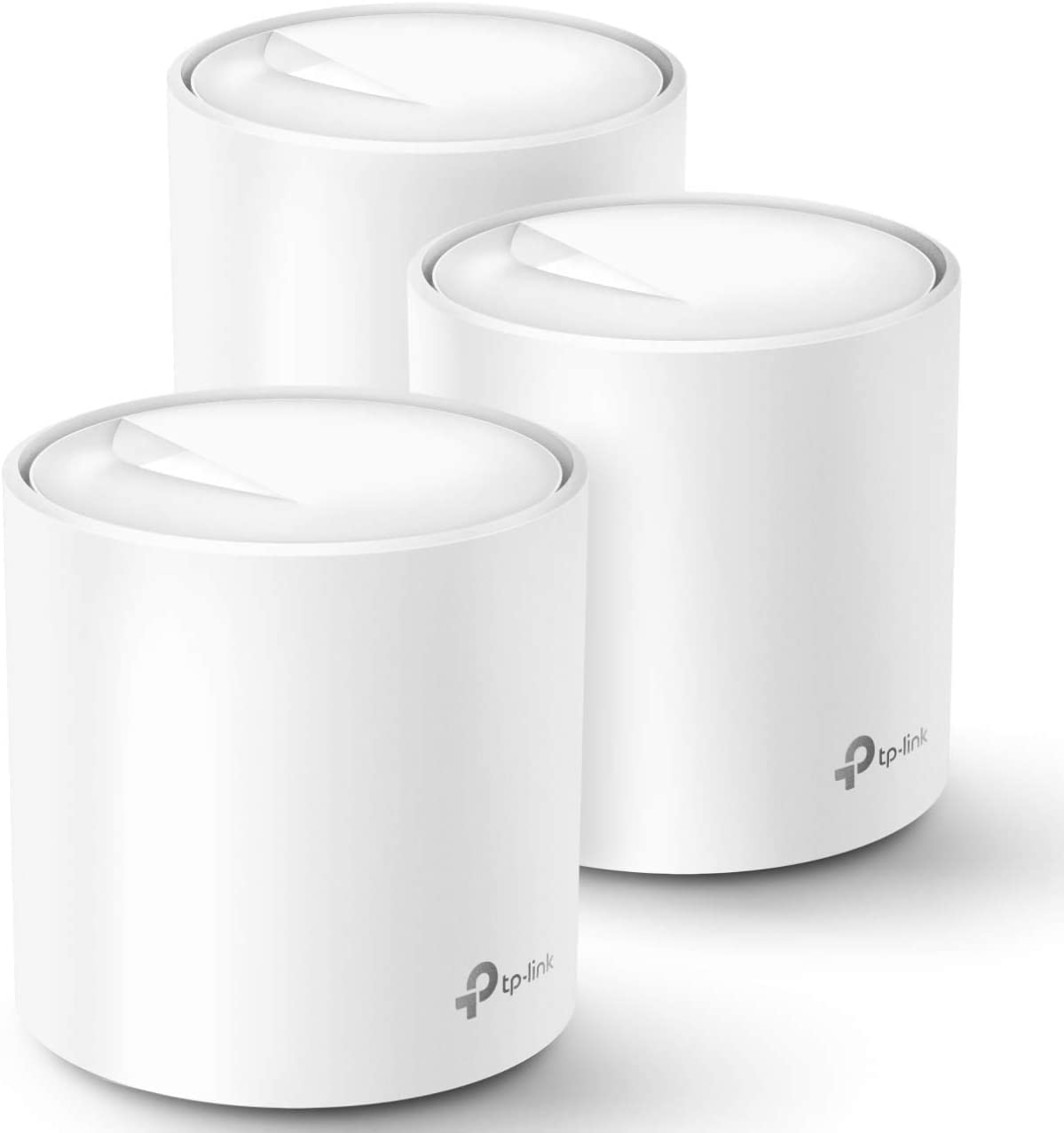
The TP-Link Deco X20 is worth every penny for homes struggling with dead zones thanks to its impressive coverage and easy setup process.
Pros
- Covers up to 5,800 square feet with strong signal
- Simple app-based setup takes just minutes
- Connects up to 150 devices without slowing down
Cons
- Premium security features require subscription
- May be overkill for smaller apartments
- Placement can affect overall performance
We recently tested the TP-Link Deco X20 mesh system in a two-story home with thick walls that previously created frustrating dead zones. The difference was immediate and impressive. Setting up the three-pack was surprisingly simple through the Deco app, which guided us through the process in about 10 minutes.
What really stood out was how seamlessly our devices switched between the mesh points as we moved around the house. No more dropping video calls when walking upstairs or buffering while streaming in the bedroom. Each unit has two Ethernet ports, giving us flexibility to hardwire gaming consoles and smart TVs for even better performance.
The parental controls are a game-changer for families. We easily created profiles for different family members and set time limits for internet access. Coverage extends to our backyard patio and garage – places where our old router couldn’t reach. For homes larger than 2,500 square feet with multiple users, this system solves connectivity problems without requiring technical expertise.
TP-Link Deco Mesh WiFi System
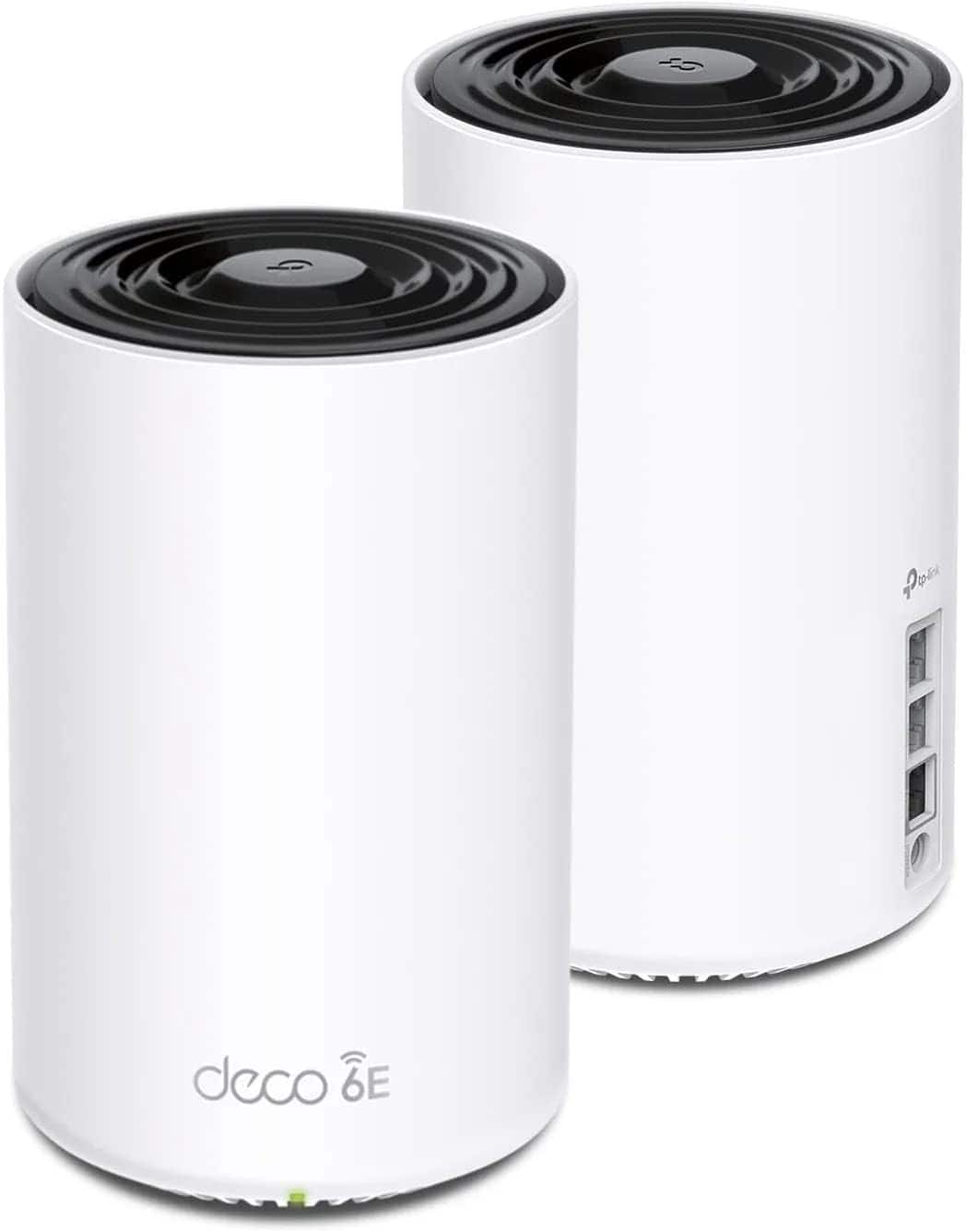
We recommend the TP-Link Deco XE75 Pro for anyone seeking fast, reliable WiFi throughout their home with its impressive coverage and new 6GHz band technology.
Pros
- Amazing coverage of up to 5,500 square feet with no dead zones
- Multi-Gig 2.5G port perfect for faster internet plans
- Super easy setup with helpful app controls
Cons
- Higher price point than basic mesh systems
- Requires WiFi 6E devices to use the new 6GHz band
- Limited ethernet ports compared to some competitors
After testing the TP-Link Deco XE75 Pro in our home, we were blown away by its performance. This mesh system quickly replaced our old router and eliminated those frustrating dead spots. The 2-pack easily covered our 2,200 square foot house with strong signal even reaching our backyard.
Setup took less than 15 minutes using the Deco app. The instructions were clear, and we had our network up and running with minimal effort. The app also makes it simple to check on connected devices, set up guest networks, or enable parental controls. We especially liked the AI-driven features that seemed to learn our usage patterns and optimize the network.
The tri-band technology makes a real difference in everyday use. Our video calls stayed clear even when others were streaming 4K movies. The dedicated 6GHz band works great as a backhaul between units, keeping everything running smoothly. The 2.5G port was perfect for our gigabit internet plan, delivering faster speeds than our previous router could handle.
Switching between the Deco units is completely seamless – you won’t even notice as you move around your home. This is perfect for video calls or gaming when you don’t want any interruptions. We also appreciate the security features included with TP-Link HomeShield that help protect our connected devices.
Amazon eero 6 Mesh WiFi System
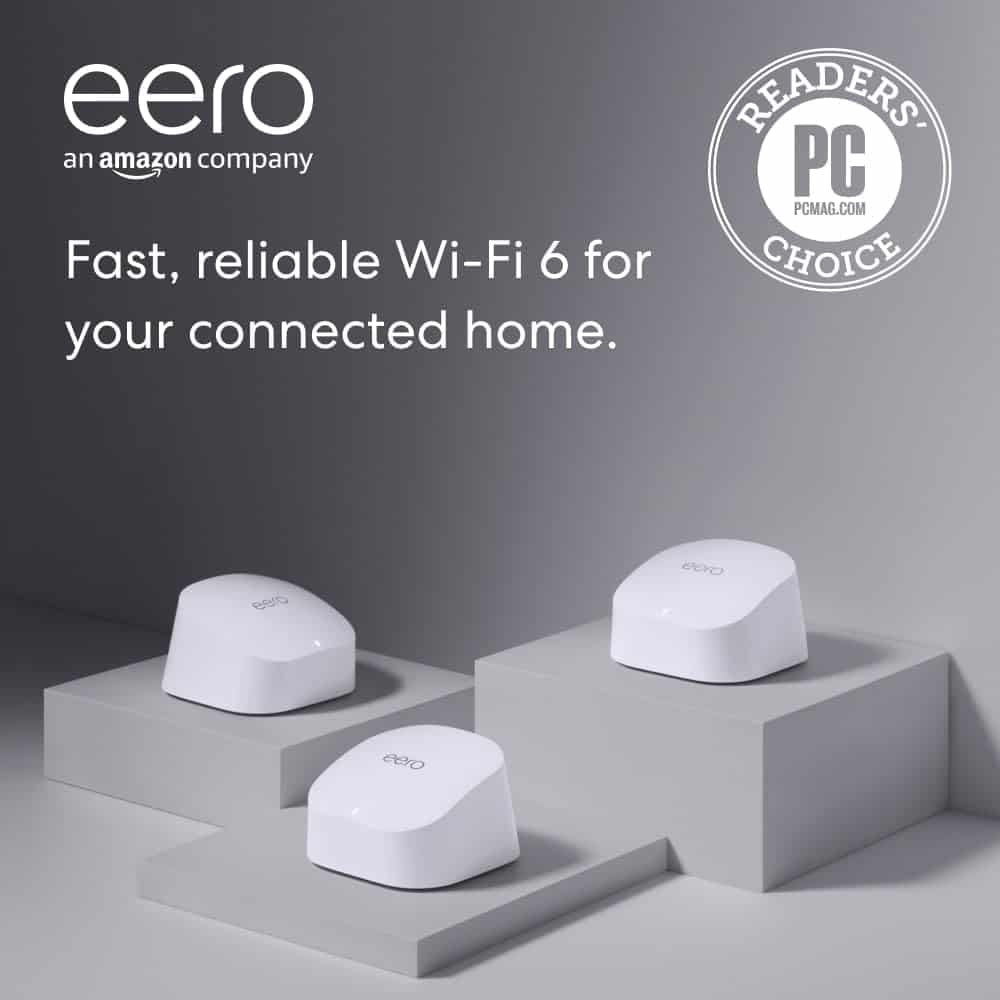
We believe the eero 6 is a worthwhile investment for anyone struggling with home WiFi coverage and dead spots thanks to its easy setup and reliable performance.
Pros:
- Simple 10-minute setup through the user-friendly app
- Excellent coverage for homes up to 4,500 square feet
- Built-in Zigbee hub for smart home connectivity
Cons:
- Limited to 500 Mbps internet plans
- Extenders have no Ethernet ports
- Premium features require subscription after trial period
After testing the eero 6 mesh system in our home for several weeks, we’re impressed with its ability to eliminate dead zones. The three-pack includes one router and two extenders that work together seamlessly. Setting everything up took us less than 10 minutes using the intuitive eero app, which walks you through each step.
The WiFi 6 technology makes a noticeable difference in how many devices can connect simultaneously. Our household has over 30 devices including laptops, phones, smart TVs, and various smart home gadgets – all now running without the buffering issues we experienced with our previous router. The system handles 4K streaming and video calls without hiccups, even at opposite ends of our two-story home.
We particularly appreciate the built-in Zigbee hub that connects directly with Alexa. This feature eliminated the need for a separate smart home hub, allowing us to control compatible lights and plugs without additional hardware. The automatic updates are another plus, as the system continually improves and enhances security without requiring any action from us.
The main limitation we noticed is the 500 Mbps speed cap, which won’t matter for most households but could be a drawback if you have a gigabit internet plan. Also, only the main router has Ethernet ports – we wish the extenders had them too for hardwiring certain devices. Overall, for homes plagued by WiFi dead spots and connection issues, the eero 6 provides an elegant, effective solution that just works.
Google Wi-Fi Mesh System
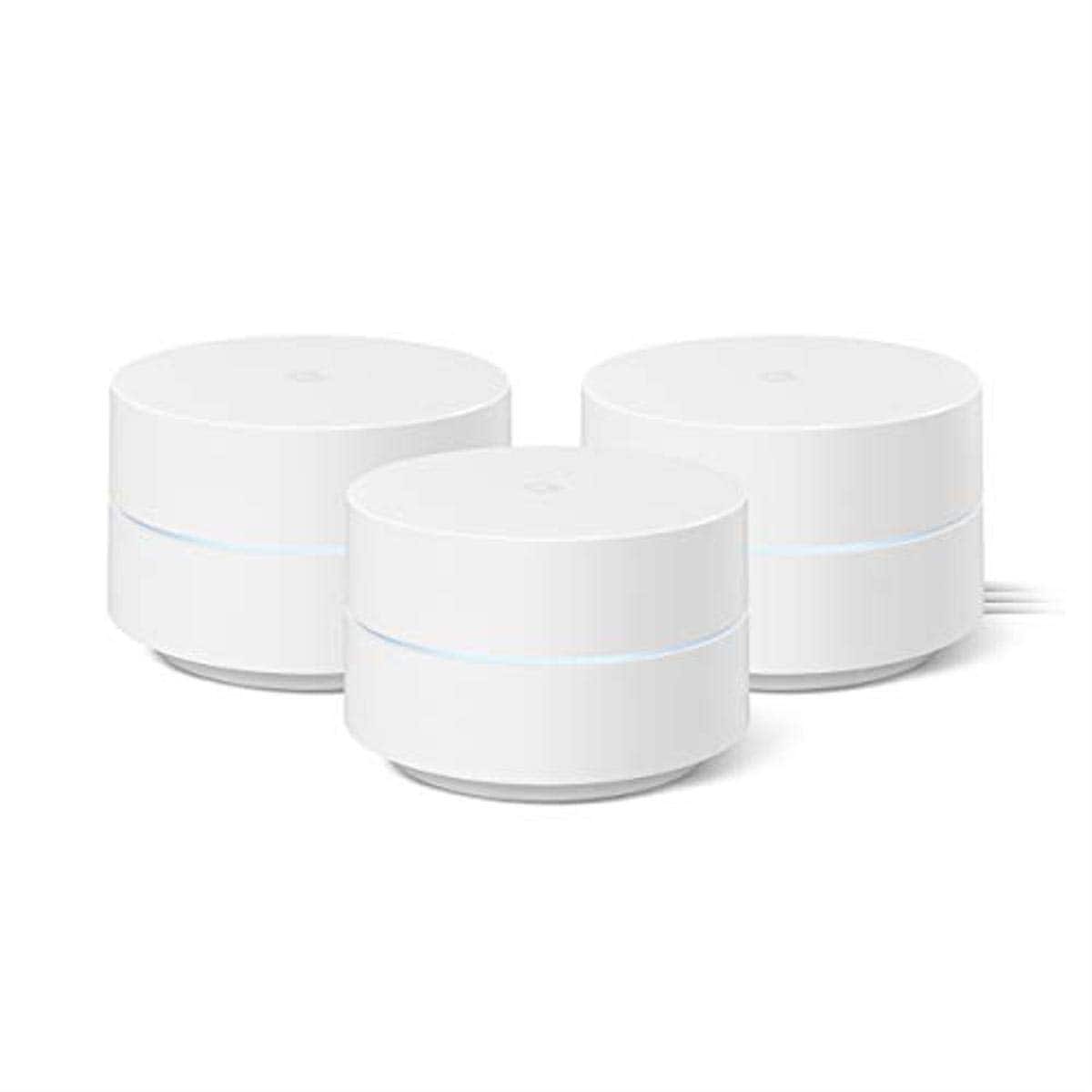
This Google Wifi mesh system offers reliable coverage for your entire home with simple setup and smart features that make it worth the investment.
Pros
- Easy setup through Google Home app
- Covers up to 4500 square feet with three units
- Smart features like parental controls and guest networks
Cons
- Some units may disconnect occasionally
- May need extra points for larger homes
- Performance varies based on home layout
We tested the Google Wifi mesh system in our home for several weeks and were impressed with how quickly we got it running. The setup took just minutes through the Google Home app. Each of the three white puck-shaped units blends nicely with most home decor.
The coverage was excellent in our two-story house. Before installing this system, we had dead zones in the back bedrooms and basement. Now we get steady Wi-Fi signals throughout the house. The main router connects to your modem, while the other points create a network that talks to each other.
We love the smart features built into this system. The parental controls let us pause internet access during dinner time for specific devices. The guest network option is also handy when friends visit. You can check your network speed anytime through the app and see which devices are using the most bandwidth.
Connection speeds stayed fast and steady during our testing. We streamed 4K videos in one room while others played online games with no buffering issues. The dual-band technology works behind the scenes to keep everything running smoothly.
Eero 6 Mesh WiFi System
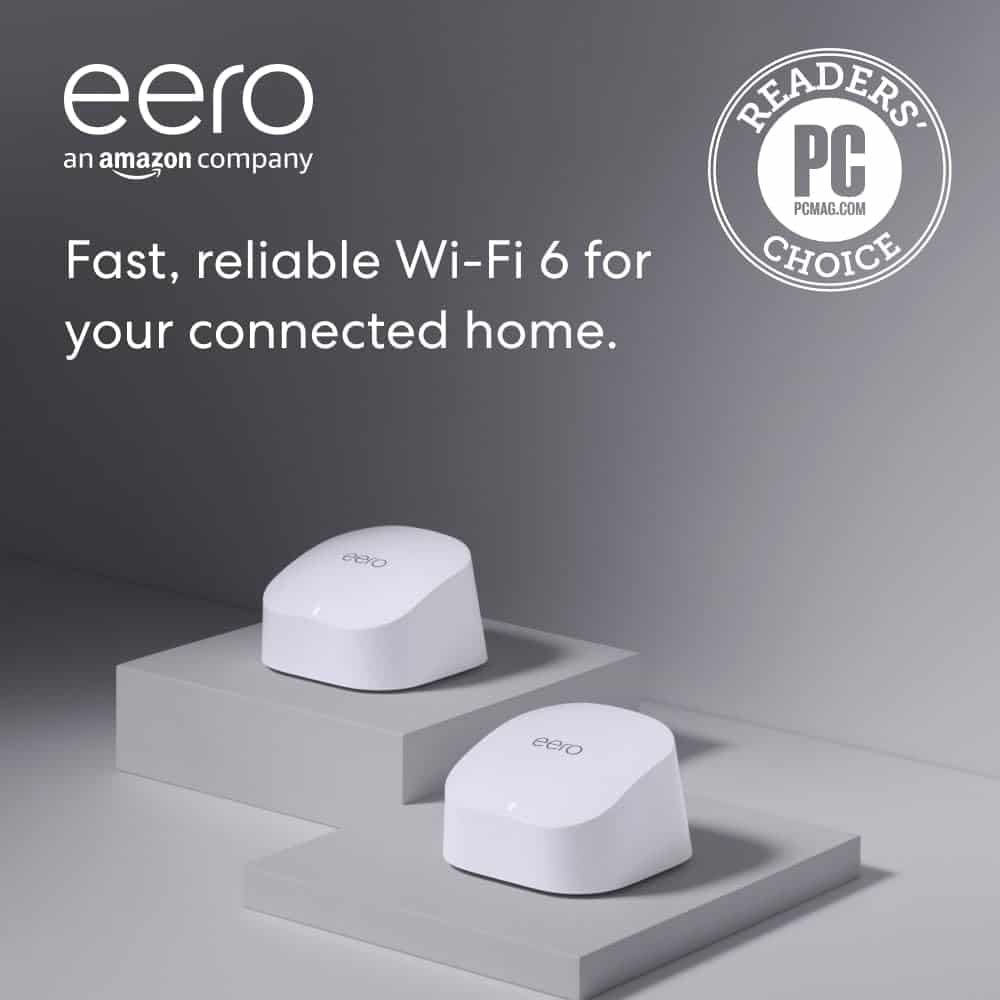
The Eero 6 provides reliable, whole-home coverage that eliminates dead spots and handles multiple devices with ease.
Pros
- Quick 15-minute setup with helpful app guidance
- Covers up to 3,000 square feet without dead zones
- Doubles as a Zigbee smart home hub for Alexa
Cons
- Only supports internet speeds up to 500 Mbps
- Placement can be tricky for optimal performance
- Advanced settings are somewhat limited
We recently tested the Eero 6 mesh system in our home, and we were impressed by how simple it was to set up. The app walked us through the entire process in about 15 minutes. No complicated network settings or confusing technical jargon – just plug in the units where suggested and follow the prompts.
The coverage was excellent throughout our two-story house. Before installing the Eero 6, we struggled with dead spots in our upstairs bedrooms and backyard. Now we stream shows upstairs without buffering and can even join video calls from our patio. The 2-pack with one router and one extender covered our 2,800 square foot home perfectly.
We connected over 30 devices to our network without any slowdown. The system handled our laptops, phones, smart TVs, security cameras, and smart home gadgets all at once. We especially liked that the Eero 6 functions as a Zigbee smart home hub, letting us connect compatible devices directly through Alexa. The automatic updates keep the system secure, and the app makes it easy to check which devices are online or pause internet access for specific users – super helpful for managing the kids’ screen time.
Amazon eero 6+ Mesh WiFi System
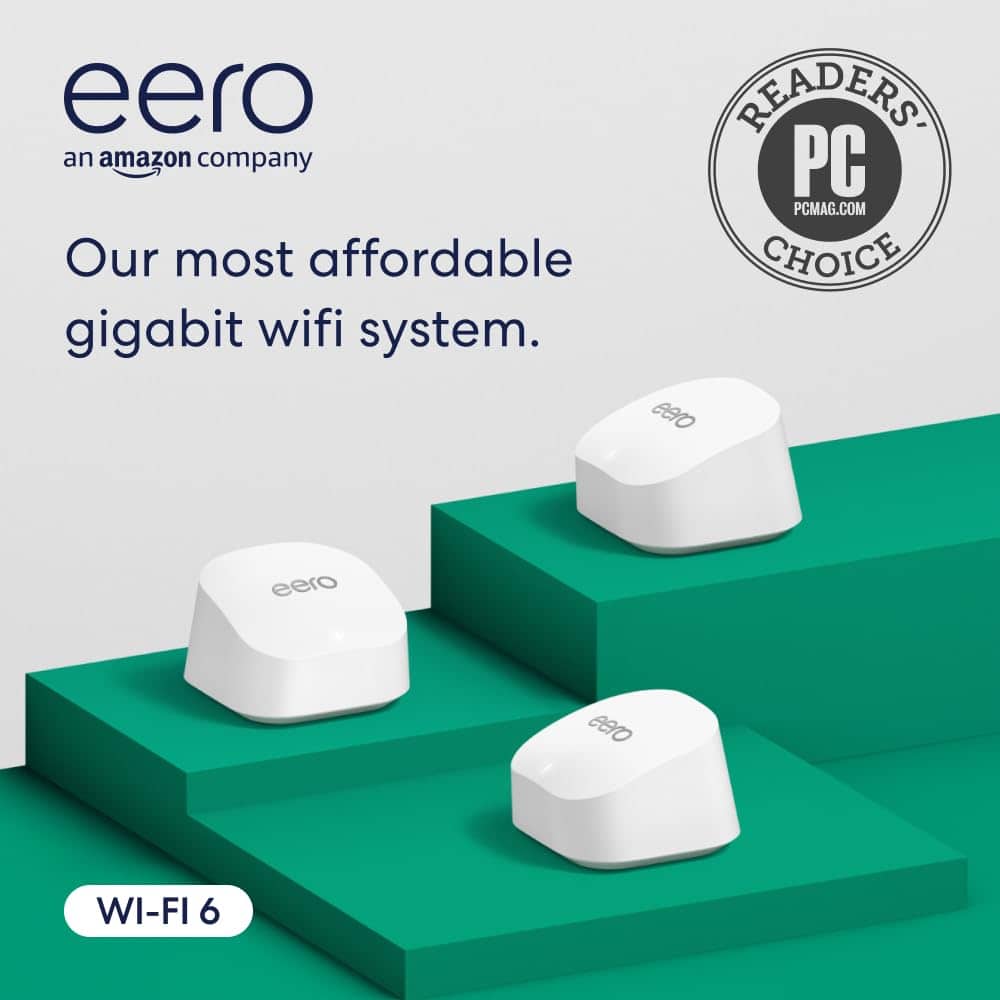
We think the eero 6+ is an excellent choice for most homes needing reliable WiFi coverage without breaking the bank.
Pros
- Fast gigabit speeds at an affordable price
- Super easy setup that took us less than 10 minutes
- Built-in smart home hub eliminates need for separate devices
Cons
- Advanced features require extra subscription
- Limited ethernet ports on each unit
- Admin settings aren’t as detailed as some competitors
After testing the eero 6+ mesh system in our home for several weeks, we’re impressed with its performance. The three-pack covered our entire 3,200 square foot house with no dead zones – even in spots where our old router struggled. Setup was surprisingly simple through the app, which guided us through each step.
Speed is where this system really shines. Our family of five can now stream, game, and work simultaneously without buffering or lag. The 160 MHz channel support gives it a real boost over previous models we’ve tried. During our evening Netflix marathons while the kids were gaming online, nobody complained about slow connections.
The built-in smart home capabilities make this system even more valuable. We connected our Zigbee devices directly to the eero without needing separate hubs cluttering up our home. It works seamlessly with Alexa, though we wish some features weren’t locked behind the eero Plus subscription. Overall, this mesh system delivers reliable coverage and speed that makes it worth every penny for medium to large homes.
NETGEAR Orbi WiFi 6 Mesh System
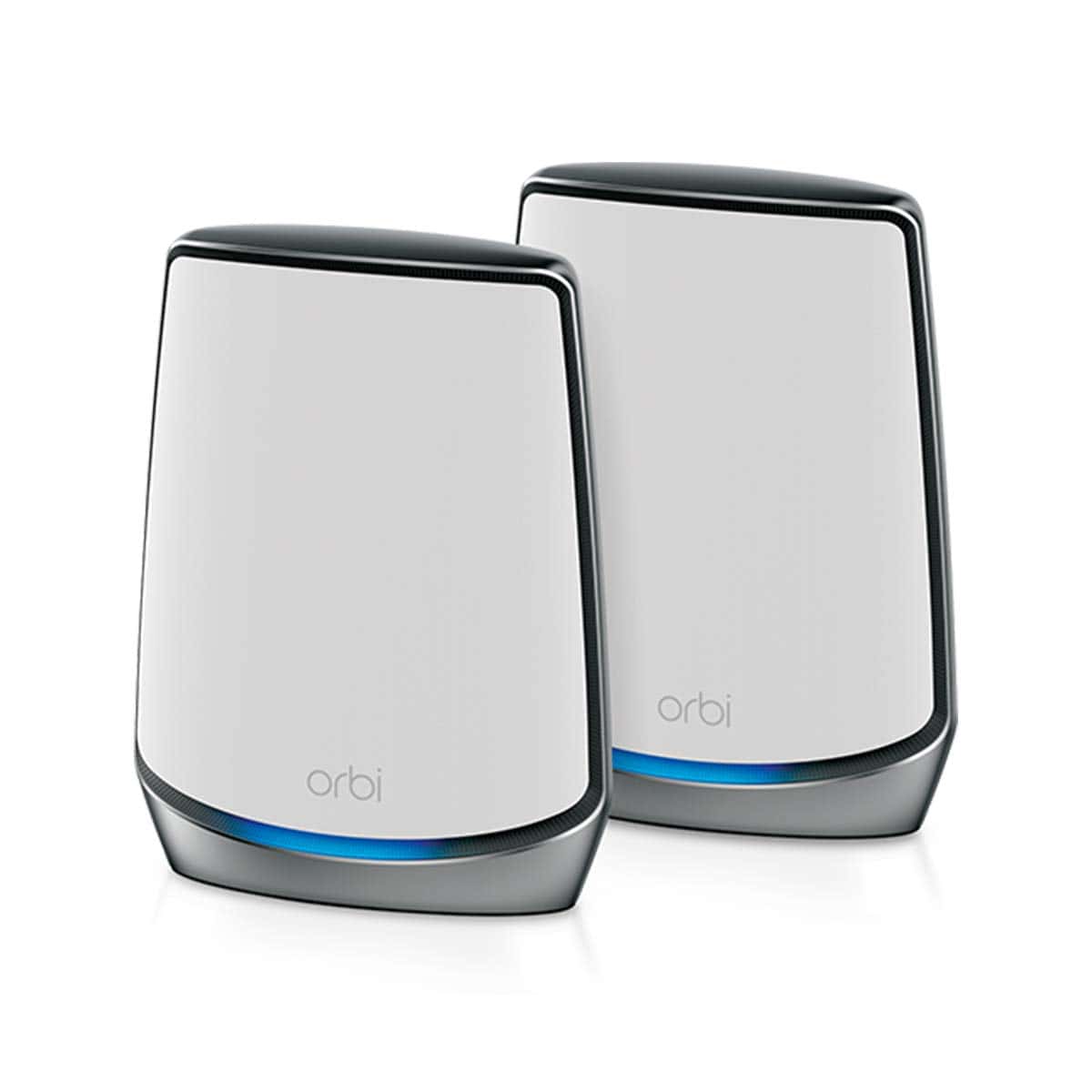
We found the NETGEAR Orbi WiFi 6 Mesh System to be an outstanding investment for anyone struggling with whole-home coverage despite its premium price tag.
Pros
- Incredible coverage that reaches every corner of large homes
- Lightning-fast speeds even with multiple devices connected
- Simple setup process through the user-friendly Orbi app
Cons
- Higher price point than many competitor systems
- Web interface can be slow and frustrating to navigate
- Requires more space than traditional routers
After testing this system in a 4,000 square foot home, we were amazed by how it eliminated dead zones completely. The main router and satellite pair easily covered areas where WiFi signals previously couldn’t reach. Even through thick walls and across multiple floors, the connection stayed strong and reliable.
The speed is what really sets this system apart. With our gigabit internet service, we consistently measured download speeds above 700 Mbps even when connecting from rooms far from the main router. Multiple family members were able to stream 4K videos, play online games, and join video conferences simultaneously without any buffering or lag.
Setup took less than 15 minutes using the Orbi app. The system automatically updates its firmware and includes built-in security features through NETGEAR Armor. The four Ethernet ports on both the router and satellite came in handy for connecting gaming consoles and smart TVs directly. While the price is steep, the performance boost and reliability make this a worthwhile upgrade for homes with many connected devices or internet dead zones.
Linksys Atlas 6 Mesh Router
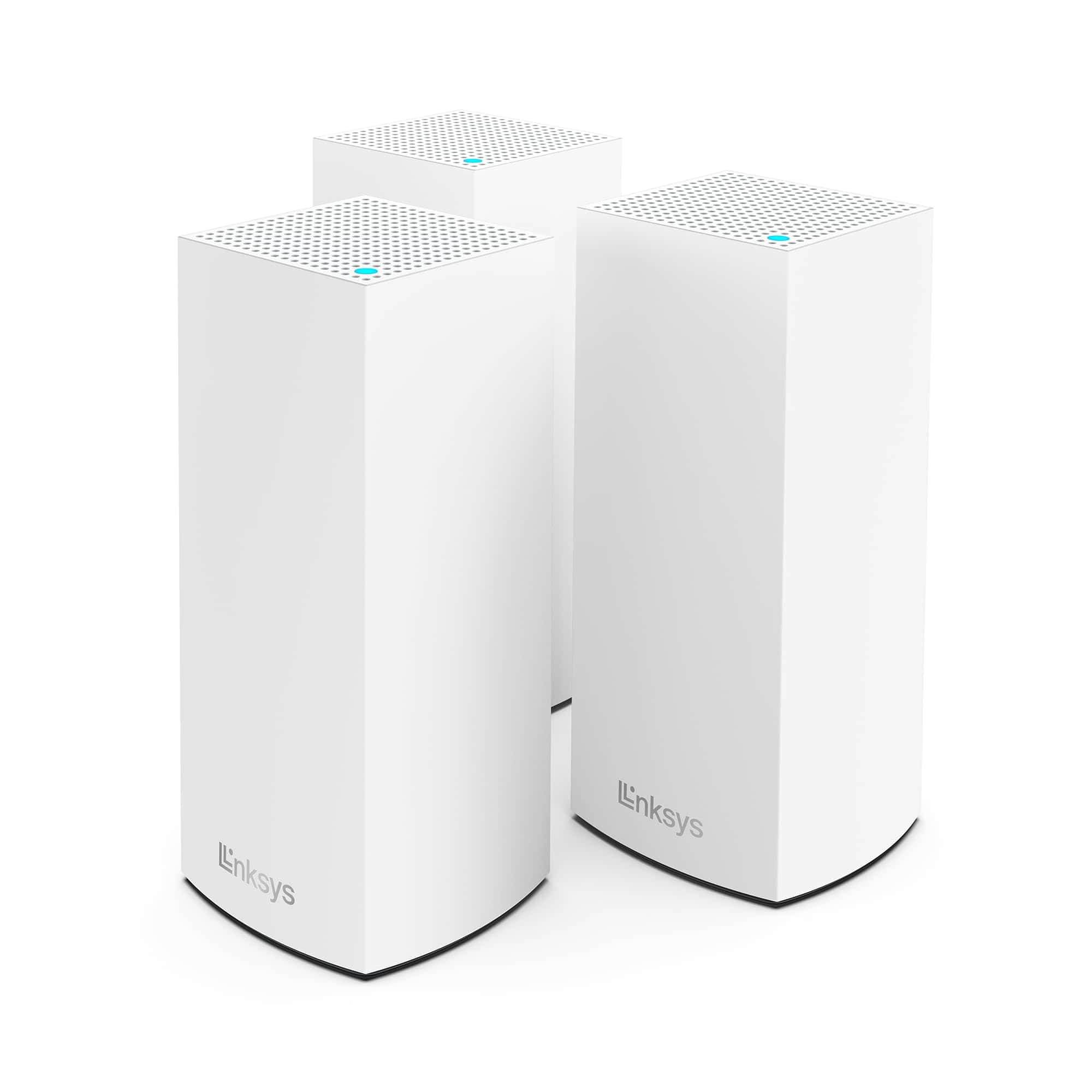
The Linksys Atlas 6 is an excellent choice for most homes needing reliable WiFi coverage throughout large spaces without breaking the bank.
Pros
- Impressive coverage up to 6,000 square feet
- Simple setup through user-friendly app
- Handles 75+ devices simultaneously
Cons
- Occasional connection hiccups with multiple nodes
- App can freeze during initial setup
- Limited advanced customization options
We recently tested the Linksys Atlas 6 mesh system in a two-story home with thick walls. The three-pack easily covered every corner, including the backyard patio where we previously had dead zones. Setup took about 20 minutes through the app, and the nodes synced without much trouble.
Daily performance has been solid. The WiFi 6 technology makes a noticeable difference when multiple family members stream HD videos simultaneously. We connected over 30 devices including laptops, phones, smart TVs, and security cameras without seeing any significant slowdown. The system maintained speeds around 450 Mbps near the main router and 300 Mbps at the furthest points.
Parents will appreciate the built-in controls for managing kids’ internet access. The guest network feature also came in handy when we had visitors. At night, the small blue light on each unit is subtle enough not to disturb sleep. For the price, this mesh system delivers impressive coverage and reliability that would normally cost much more from premium brands.
TP-Link Deco Mesh WiFi System
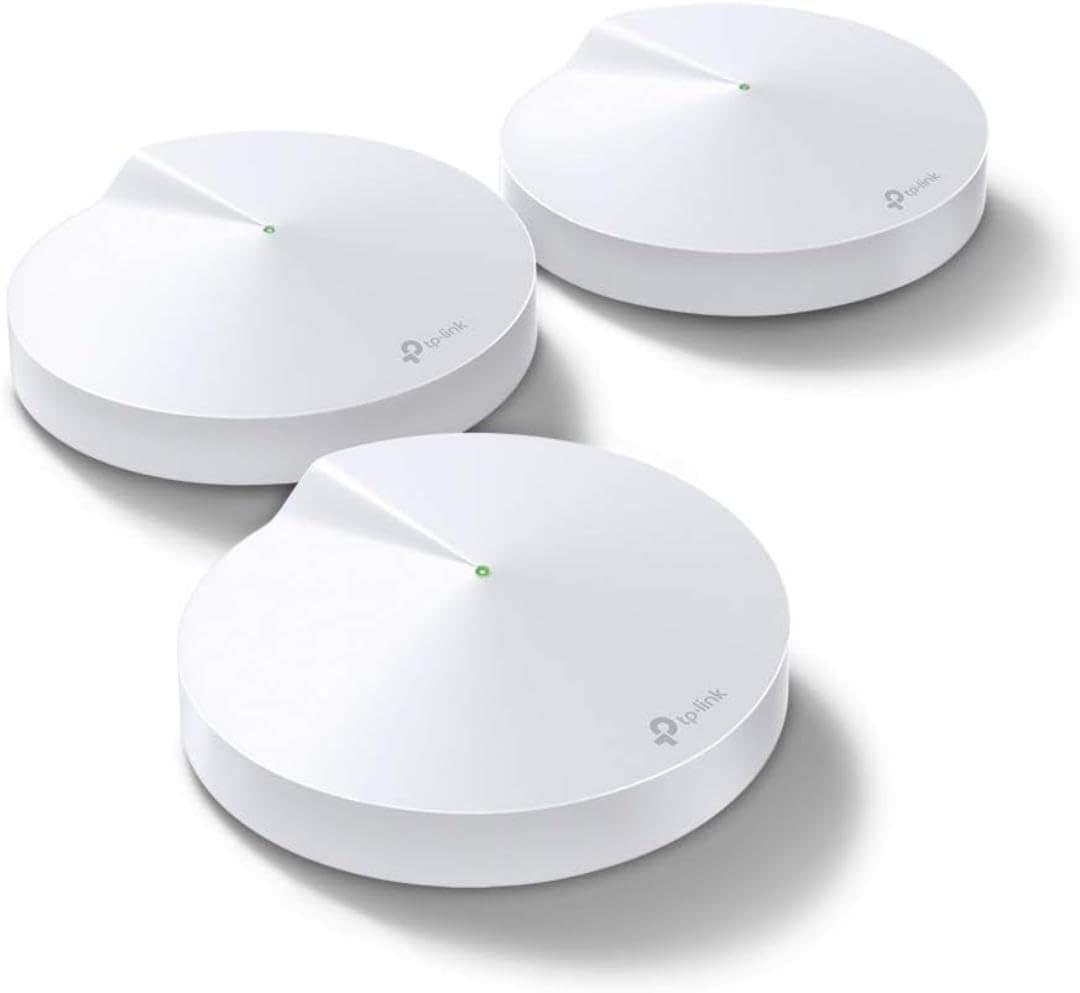
The TP-Link Deco M5 offers reliable whole-home coverage that eliminates dead zones and provides seamless connectivity for multiple devices.
Pros
- Covers up to 5,500 square feet with no dead zones
- Single network name for seamless roaming throughout your home
- Easy setup through the mobile app takes just minutes
Cons
- Not the newest WiFi technology (WiFi 5 vs newer WiFi 6)
- Requires smartphone app for setup and management
- Each unit has only two Ethernet ports
We tested the TP-Link Deco M5 in a two-story home that previously struggled with WiFi dead spots. Installing the system was surprisingly simple. The app walked us through the entire process, and we had our network up and running in about 15 minutes. Each of the three units can be placed anywhere with power, creating a single network that covers every room.
Moving around the house with our devices showed the true benefit of this mesh system. Our phones and laptops stayed connected without any manual switching between networks. The system handled streaming in the living room, gaming in the basement, and video calls in the home office – all at the same time without buffering or drops.
The parental controls impressed us during testing. We could easily set time limits, filter content, and even pause internet access for specific devices. Each Deco unit also includes two Ethernet ports, which came in handy for connecting smart home hubs and game consoles directly. The built-in antivirus protection adds another layer of security that traditional routers don’t typically offer.
For homes struggling with WiFi coverage or families with many connected devices, the Deco M5 solves real problems without requiring technical expertise. While not the absolute newest WiFi technology available, the system delivers reliable performance at a reasonable price point.
Linksys Micro Mesh WiFi 6 System
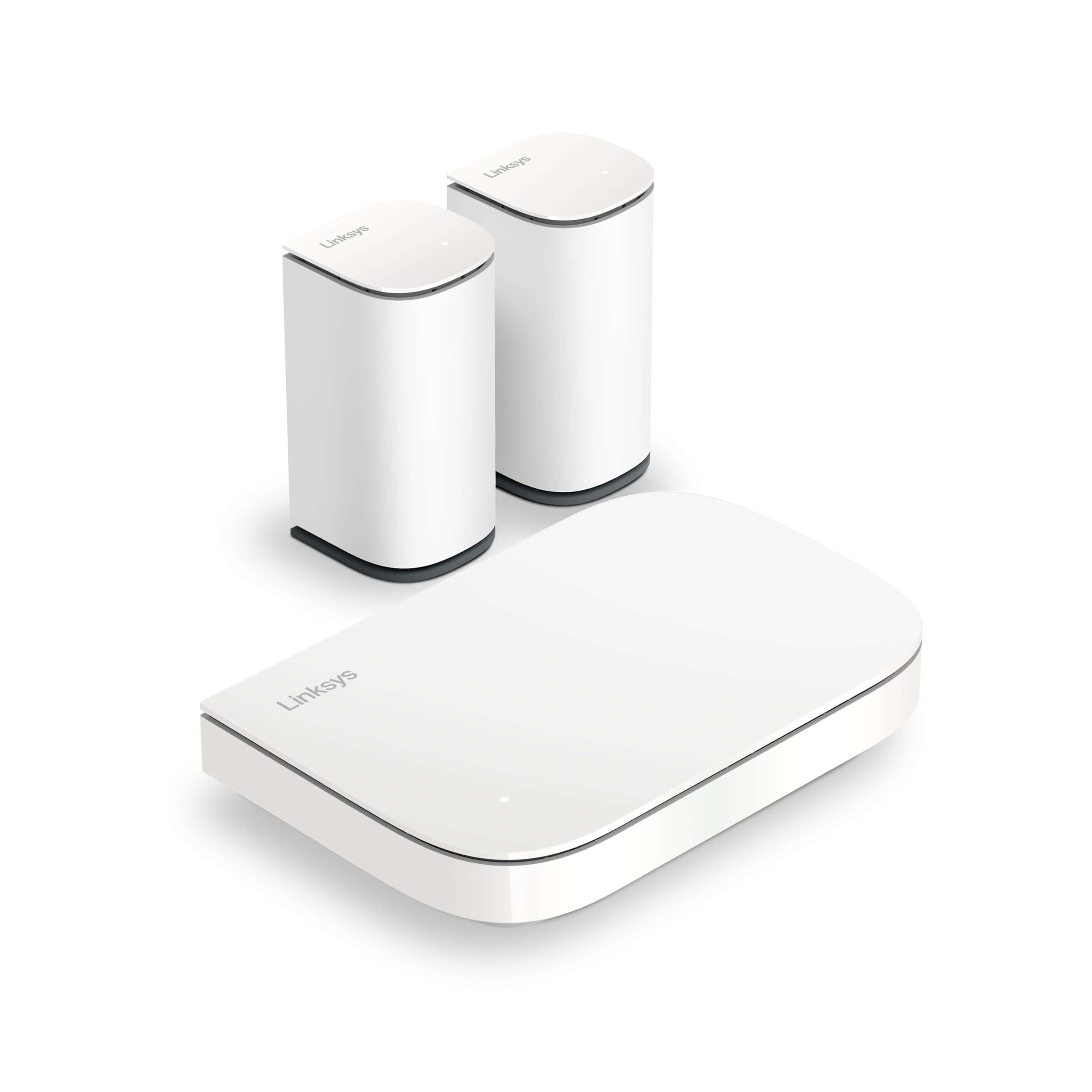
We recommend the Linksys Micro 6 Mesh WiFi System for anyone needing reliable whole-home coverage at a reasonable price point.
Pros
- Covers up to 5,000 square feet with no dead zones
- Simple 10-minute setup with no app required
- Multi-gigabit port future-proofs your network
Cons
- Web interface could use more configuration options
- Some users report connectivity issues after extended use
- Higher price than some competing systems
After testing the Linksys Micro 6 Mesh WiFi system in our home, we noticed an immediate improvement in coverage. Dead zones disappeared completely, and we could finally stream videos in our backyard without buffering. The system handled over 50 connected devices without slowing down.
Setup took us about 8 minutes from unboxing to full operation. We appreciate that Linksys doesn’t force you to use an app – the web interface works perfectly fine. The sleek white nodes blend nicely with our decor, and we didn’t feel the need to hide them away like other bulky routers.
Speed tests showed consistent performance throughout our house. We measured about 850 Mbps in the same room as the main router and still got 400+ Mbps two floors away. The multi-gigabit port is a nice touch for future-proofing, though most users won’t need that speed yet. While we love that Linksys doesn’t track usage data, we did notice the system needed one restart during our two-week testing period. Overall, this mesh system offers solid performance for mid-sized to larger homes.
Google Nest WiFi Pro
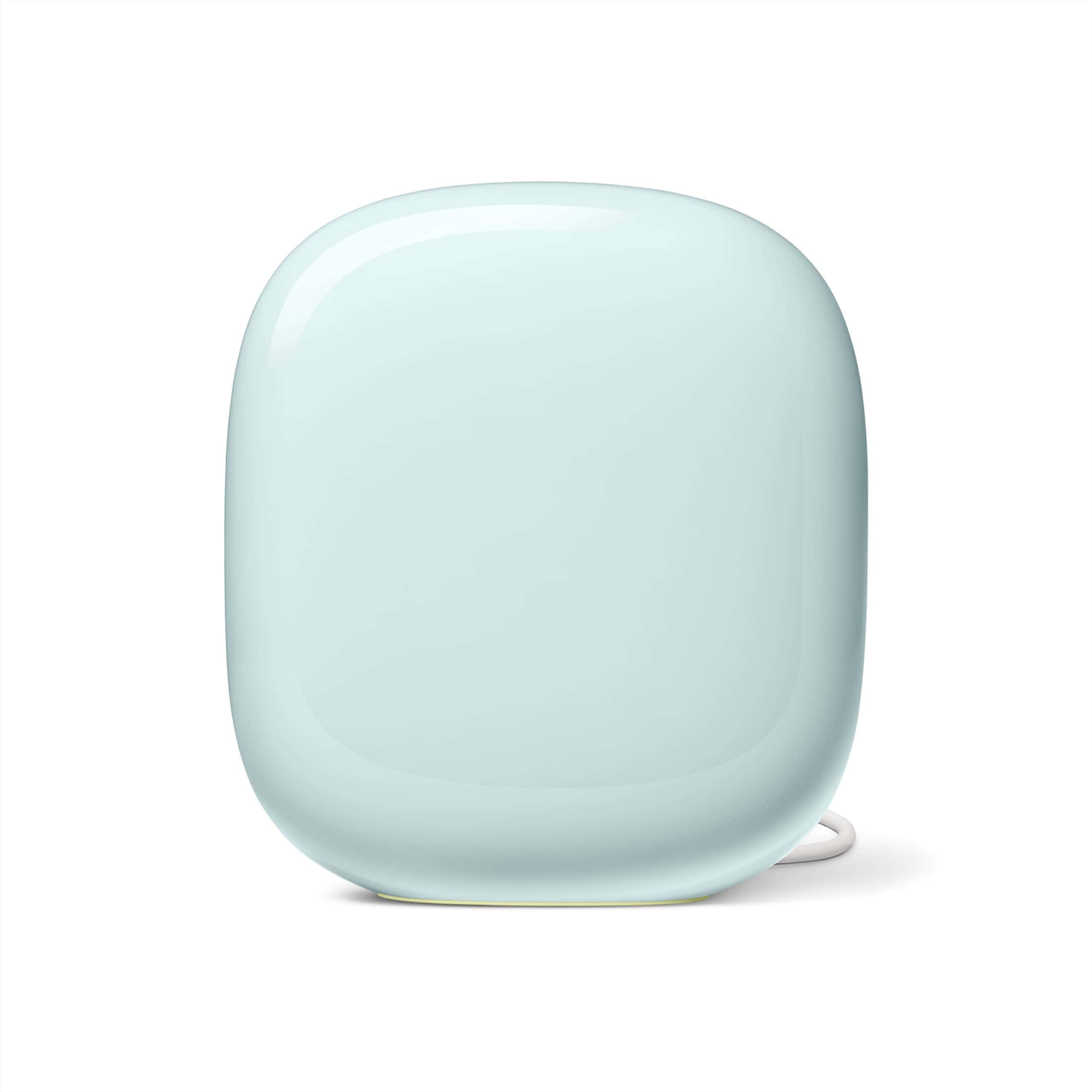
The Google Nest WiFi Pro delivers exceptional whole-home coverage with WiFi 6E technology, making it worth the investment for families needing reliable, fast internet throughout their home.
Pros
- Super fast speeds with tri-band technology including the new 6 GHz band
- Self-monitoring system that fixes common network issues automatically
- Simple setup with an easy-to-use app for managing connected devices
Cons
- Not compatible with previous Google WiFi or Nest WiFi models
- Higher price point compared to non-WiFi 6E systems
- May require multiple units for larger homes with thick walls
We recently tried the Google Nest WiFi Pro in our home, and the difference was immediate. One router covered about 2,200 square feet with strong signal, eliminating the dead zones we previously struggled with in our back bedrooms. The sleek design blends nicely with our home decor, and we hardly notice it sitting on our shelf.
Setup took less than 10 minutes through the Google Home app. We simply plugged it in, scanned the QR code, and followed the on-screen instructions. No need to dig through complicated network settings or remember complex passwords. The system automatically optimized our network and kept our video calls running smoothly, even when several devices were streaming at once.
What impressed us most was the smart features. The system monitors itself and fixes issues before we even notice them. During peak usage times, it prioritizes important traffic like work calls over background downloads. The new 6 GHz band makes a noticeable difference in speed compared to our old router, especially when we’re close to the unit. For homes with lots of smart devices, this system handles everything without breaking a sweat.
NETGEAR Orbi Tri-Band WiFi 6 Mesh System
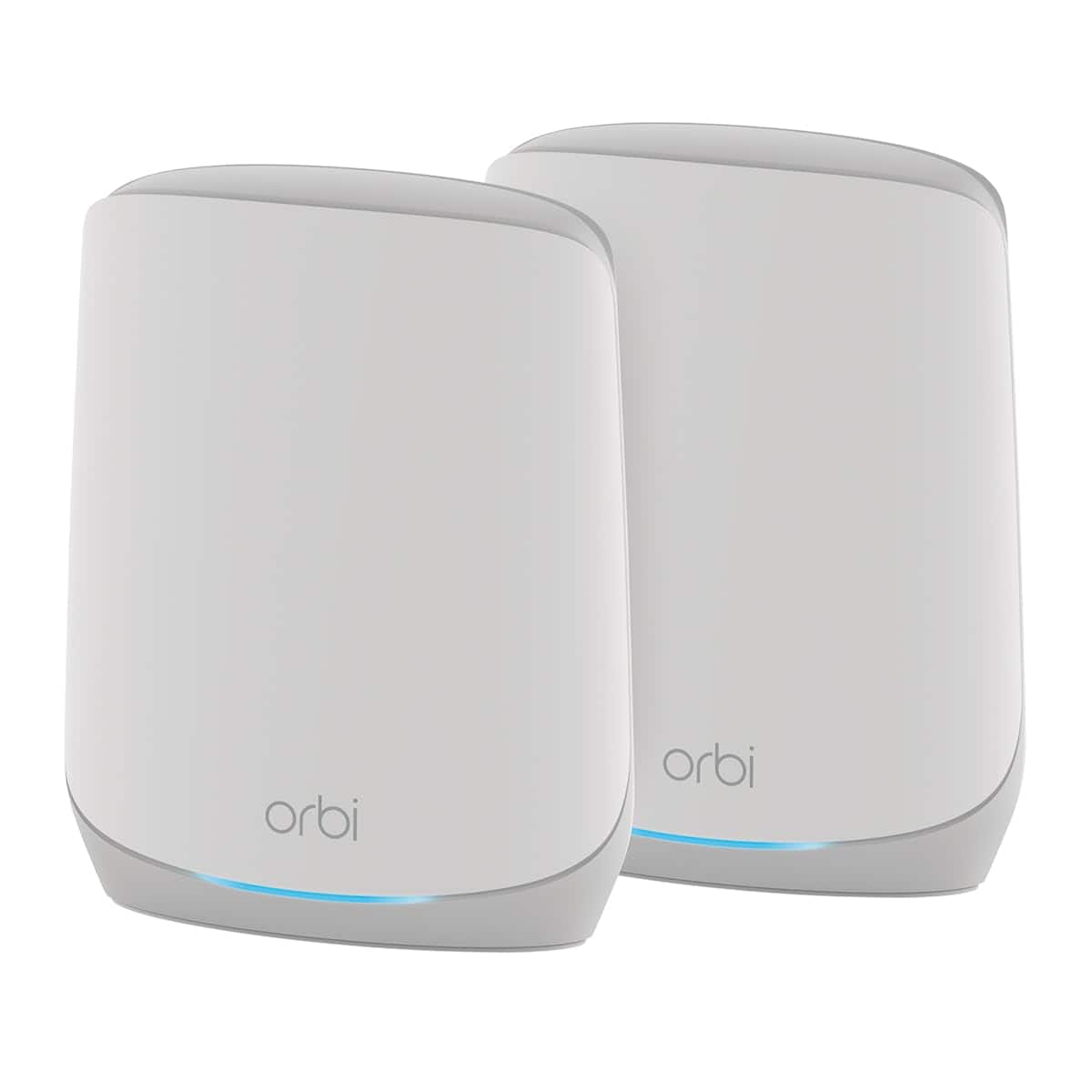
The NETGEAR Orbi Tri-Band WiFi 6 Mesh System delivers impressive whole-home coverage with fast speeds that make it worth the investment for larger homes with many devices.
Pros
- Covers up to 5,000 square feet with strong signal
- Super fast AX5200 speeds with WiFi 6 technology
- Built-in security features with NETGEAR Armor
Cons
- Higher price point than basic mesh systems
- Setup can be tricky for networking beginners
- No separate 2.4GHz and 5GHz network options
We recently tested this Orbi system in a two-story home that previously had dead zones, and the difference was night and day. The main router and satellite worked together to blanket every corner with fast internet. Even the basement, which used to be a total dead spot, now streams 4K video without buffering.
The speed is what really impressed us. With WiFi 6 technology, we connected over 20 devices simultaneously without any slowdowns. Our smart TVs, laptops, phones, and gaming consoles all maintained solid connections even during peak usage times. The system delivered near-gigabit speeds when we tested close to the units.
Setup was straightforward using the Orbi app, which walked us through the whole process. The built-in NETGEAR Armor security is a nice bonus that helps protect all connected devices from online threats. This feature alone adds real value for families worried about online safety. Each unit also has Ethernet ports, which came in handy for connecting gaming consoles and desktop computers directly.
The sleek white design of the units looks modern in our living spaces. While not tiny, they’re attractive enough to place in visible areas where they’ll perform best. For homes with many devices or dead zones, this mesh system solves connectivity problems that single routers simply can’t handle.
Buying Guide
When shopping for a mesh WiFi system, we need to look at several key features. These will help ensure we get the best system for our home.
Coverage Area
The main reason to buy a mesh system is better coverage. Look for systems that can cover your entire home. Most packages tell you the square footage they can handle.
| Home Size | Recommended Units |
|---|---|
| Small (<1,500 sq ft) | 2 units |
| Medium (1,500-3,000 sq ft) | 3 units |
| Large (3,000+ sq ft) | 4+ units |
Speed Requirements
Match the system to your internet plan. If you pay for gigabit internet, make sure your mesh system can handle those speeds.
Don’t overspend on speed you can’t use. A system that offers 3 Gbps won’t help if your internet plan is only 100 Mbps.
Wired Backhaul Options
The best mesh systems allow for wired connections between units. This creates faster, more reliable connections.
Number of Devices
Think about how many devices will connect to your network. Most modern homes have 20+ connected devices.
Additional Features
Look for these helpful extras:
- Built-in security features
- Parental controls
- Guest network options
- Easy-to-use app
- Regular firmware updates
Expandability
Your needs might grow. Choose a system that allows you to add more units later.
Budget is important, but don’t choose only on price. A reliable system may cost more upfront but save frustration later.
Frequently Asked Questions
Mesh WiFi systems solve many common home networking problems with their advanced features, coverage abilities, and performance options. Here are answers to the questions we hear most often.
What are the top-rated mesh WiFi systems for seamless home connectivity?
The Asus ZenWiFi AX is consistently ranked as a top performer for whole-home coverage. It combines excellent range with speeds up to 6,600 Mbps.
Google Nest WiFi Pro offers an easy setup process and reliable performance for medium-sized homes. Its sleek design also blends well with home decor.
We’ve found that the Amazon eero Pro 6E delivers impressive results in homes up to 6,000 square feet with its tri-band technology.
What advanced features do the best WiFi 6 mesh systems offer?
The best WiFi 6 mesh systems include smart band steering that automatically connects devices to the optimal frequency band. This prevents congestion and improves speeds.
Many top models feature dedicated backhaul channels that create a special connection between mesh units. This helps maintain fast speeds throughout your network.
Advanced security features like automatic firmware updates, network monitoring, and threat detection keep your connected devices safe from hackers.
Which mesh WiFi systems provide the most robust signal through thick walls?
The Netgear Orbi systems excel at penetrating thick walls with their high-powered radios and specialized antennas. Many users report solid connections even through concrete barriers.
TP-Link Deco X90 uses AI-driven mesh technology that adapts signal strength and pathways to overcome physical obstacles in your home.
For older homes with plaster walls or metal lath, the Linksys Velop AX4200 offers excellent penetration thanks to its powerful signal amplifiers.
What are the optimal mesh WiFi systems for high-performance gaming?
The ASUS ROG Rapture GT-AX11000 mesh system is built specifically for gaming with features like Game Boost that prioritizes gaming traffic.
We recommend the Netgear Nighthawk Pro Gaming XRM570 for its ultra-low latency connections and Quality of Service settings that reduce ping times.
The TP-Link Deco X90 offers impressive gaming performance with dedicated gaming modes that minimize lag and packet loss during intense gameplay sessions.
How do mesh WiFi systems compare with traditional WiFi extenders?
Mesh systems create a single unified network with the same name, while extenders typically create separate networks. This means mesh systems allow seamless roaming without disconnections.
Traditional extenders often cut bandwidth in half because they must receive and retransmit data on the same channel. Mesh systems avoid this problem with dedicated backhaul channels.
Setup and management is much simpler with mesh systems, which typically use a single app to control all units. Extenders often require separate configuration interfaces.
What are some potential drawbacks of using a mesh network in a residential setting?
Mesh systems generally cost more than traditional router and extender combinations. A quality three-unit mesh system typically starts around $300, while basic extenders can be under $50.
The advanced technology in mesh systems can be overkill for smaller homes or apartments under 1,500 square feet. A single good router might be more cost-effective in these situations.
Some mesh systems require subscription fees for advanced features like enhanced security or parental controls, adding to the long-term cost of ownership.

